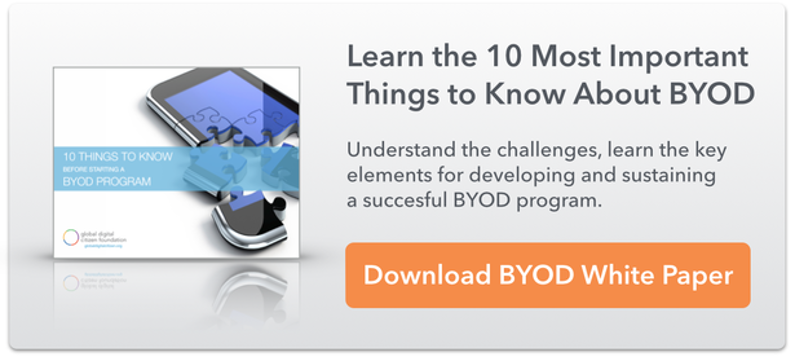The Top Ways Digital Tools Transform Learning
Digital tools are often touted for their ability to have a transformative effect on teaching and learning, and an annual survey reveals just how deeply these tools continue to impact education.
Project Tomorrow CEO Julie Evans shared some of the latest Speak Up Survey data during an exclusive edWeb webinar. The annual survey focuses on digital tools, emerging technologies, professional development, digital citizenship, STEM, and administrators’ challenges.
“We have a strong belief that today’s students should be well-prepared for the future, and digital tools can help ensure that they are prepared,” Evans said.
When it comes to district administrators’ views on solutions that can most transform teaching and learning, their top motivating factors include enhancing teacher effectiveness (58 percent), integrating 21st century skills into curriculum (49 percent), and leveraging technology more effectively (46 percent).
Students surveyed said their path to a more personalized learning experience includes social-based learning involving interaction with peers and real-world experts, untethered learning that helps students learn outside the physical boundaries of a classroom or classroom resources, and digitally-rich learning that adds relevance and context to the learning process.
Teachers who self-assessed their use of digital tools as “advanced” (28 percent of respondents) use a variety of digital tools and approaches, including:
- Internet to research information about a lesson (90 percent)
- Watching online videos to learn (74 percent)
- Text with colleagues (67 percent)
- Customize digital content for class use (56 percent)
- Participate in online professional learning communities (55 percent)
Teachers’ use of digital content in the classroom includes:
- Videos found online (47 percent of elementary school teachers and 49 percent of middle school teachers)
- Game environments (35 percent of elementary and 21 percent of middle)
- Online textbooks (22 percent of elementary and 29 percent of middle)
- Real-time data (21 percent of elementary and 19 percent of middle)
- Animations (19 percent of elementary and 22 percent of middle)
- Self-created videos (6 percent of elementary and 11 percent of middle)
Gaming as a digital learning tool has increased dramatically from 2007 to 2013, when survey responses were collected.
Among K-2 students, it increased from 60 percent to 68 percent; from 47-60 percent among grades 3-5 students; from 40-48 percent among grades 6-8 students, and from 23-30 percent among grades 9-12 students.
Elementary school teachers say that games within the classroom:
- Increase student engagement (79 percent)
- Address different learning styles (72 percent)
- Reinforce understanding (53 percent)
- Provide practice opportunities (52 percent)
- Visualize difficult concepts (43 percent)
- Gain immediate feedback (38 percent)
- Personalize the learning process (34 percent)
In terms of personalized learning, middle school students said online learning’s top advantages include its ability to let students work at their own pace (52 percent) and students’ ability to be in charge of their own learning (52 percent).
Students have access to a plethora of personal mobile devices, and as Gates noted, they often have more than one device.
Grades K-2 students most often have tablets and laptops; grades 3-5 students most often have tablets, laptops, and smartphones; grades 6-8 students most often have tablets, laptops, and smartphones; and grades 9-12 students overwhelmingly have personal access to smartphones, followed by laptops.
“It’s not an either-or situation,” Gates said. “Students often differentiate the academic tasks they’re doing across these different devices.”
For full data and information on digital tools’ impact on teaching and learning, access Project Tomorrow’s The New Digital Playbook.
This post originally appeared on eClassroom News and was written and researched by the eSchool News staff.

